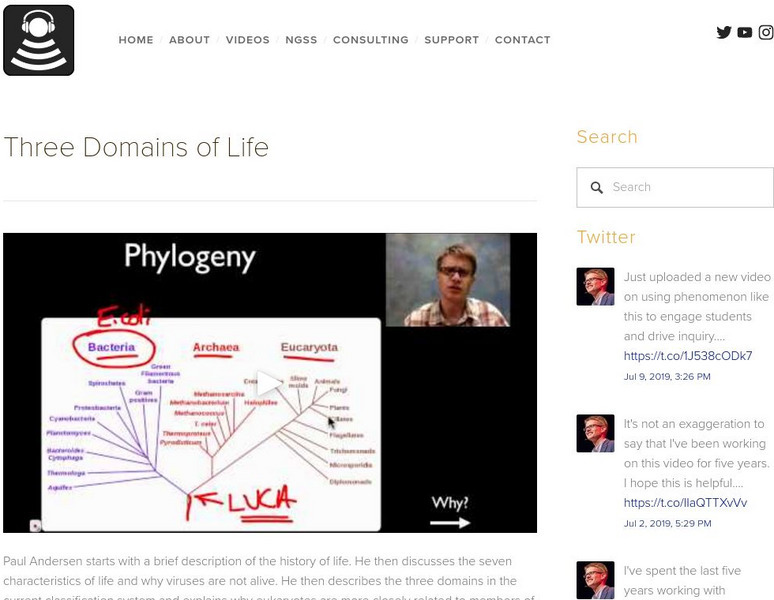Hi, what do you want to do?
Bozeman Science
Mechanisms that Increase Genetic Variation
Learn how genetic variation occurs within prokaryotes through transformation, transduction, and conjugation. The instructor then explains how sexual reproduction in eukaryotes can lead to crossing over, random assortment, and random...
Bozeman Science
Protists
Where do we put the organisms that don't fit in the other eukarya groups? We call them protists. A video explains why there is so much variety within the kingdom and the few things they do have in common with each other.
Bozeman Science
Archaea
There's archaea in my primordial soup! Viewers watch a video that explains what an archaea is, why it took us so long to find them, how they are different from eucaryota and bacteria, and the interesting discoveries about their...
Crash Course
The History of Life on Earth
The first life on Earth developed in the oceans. As an introduction to ecology, the video starts with the formation of the earth. It follows with the Archaean and Proterozoic Eons including protobionts, prokaryotes, and eukaryotes. It...
Ricochet Science
Prokaryotic Vs. Eukaryotic Cells
Viewers learn about prokaryotic and eukaryotic cells in the third installment of a five-part video series. The video covers the similarities and differences between these two types of cells, including a brief etymological aside on how...
Amoeba Sisters
DNA Replication: The Cell's Extreme Team Sport
Hey Ligase, what have you been up to? Just making ends meet. Watch a video that uses cartoon graphics to teach DNA replication in a clear and concise manner. It begins with the where and when, then covers helicase, primase, DNA...
Amoeba Sisters
Prokaryotes and Eukaryotes
Why does the mushroom go to every party? Because he's a fungi. The video covers prokaryotes and eukaryotes using real-life examples like fungi. It also offers an explanation of why the cell membrane and the cell wall are different.
TED-Ed
How We Think Complex Cells Evolved
Being able to absorb the abilities of other life forms may seem like something taken from a superhero movie, but sometimes reality is stranger than fiction. Join the narrator as he takes viewers back billions of...
Curated OER
Cell Biology
Look here for a narrative approach to cells origins and discovery by microscopes. Though it is a slightly older clip, it contains some lovely footage of cells up close. Begin with prokaryotes and move onto eukaryotes and the differences...
Curated OER
Miracle Planet - Snow Ball Earth 4/5
A snowball earth would stay frozen once frozen; so what melted the ice? A manganese dioxide deposit gives some clue. One scientist focused on volcanic eruptions as contributing more oxygen into the air and warming the earth. This...
Curated OER
Plant and Animal Cell Overview: The Basics
George Wolfe explains the parts of a eukaryotic cell very energetically. Surface area and volume are reviewed in order to show that a giant amoeba could not exist. Show your junior high or high school class this video to begin talking...
PBS
Pbs Learning Media: The Discovery of Penicillin
This video segment adapted from A Science Odyssey tells the story of researcher Sir Alexander Fleming, whose luck and scientific reasoning led to the groundbreaking discovery of penicillin. [4:45]
Khan Academy
Khan Academy: How Do Earth and Life Interact?
A look at the 'comfort zone' humans live in, and the interplay of life and the biosphere. [9:58]
Crash Course
Crash Course Big History #4: Life Begins
The Crash Course guys teach about life on Earth- the earliest forms of life on Earth, and some of the ways that they developed into other forms. [13:29]
Other
Richochet Science: Prokaryotic and Eukaryotic Cells Video
Understand the distinction between eukaryotic and prokaryotic cells in this quick, but well illustrated video. [1:46]
Bozeman Science
Bozeman Science: Gene Regulation
Paul Andersen explains how genes are regulated in both prokaryotes and eukaryotes. He begins with a description of the lac and trp operon and how they are used by bacteria in both positive and negative response. He also explains the...
Bozeman Science
Bozeman Science: Three Domains of Life
Paul Andersen starts with a brief description of the history of life. He then discusses the seven characteristics of life and why viruses are not alive. He then describes the three domains in the current classification system and...





















